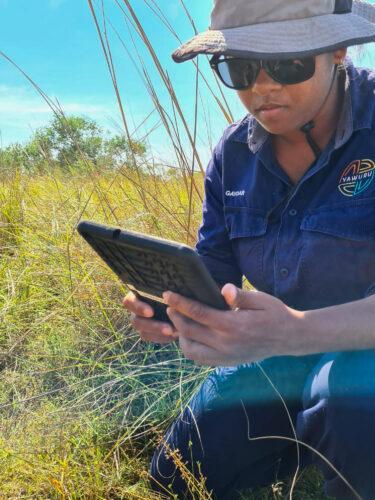Project start date: 01/04/2024
Project end date: 30/10/2025
NESP funding: $257,134 (GST-exclusive)
Wetlands within the Kimberley region are critical ecosystems from a conservation perspective, with their health closely tied to Traditional Owner ways of knowing, being and doing. However, Kimberley wetlands face widespread threats from increased water-development, climate change, and invasive and feral species.
Indigenous ranger teams throughout Northern Australia protect wetlands from threats using various management actions (e.g. fencing, weeding, protective burning, monitoring, and knowledge sharing). Rangers are also challenged with measuring if these efforts are achieving their desired outcomes, that is, enhancing values or mitigating threats.

Nyamba Buru Yawuru Country Manager, Gaydar Lawford, recording wetland data on a FULCRUM app. Photo by Rebecca Dobbs
This project is creating a wetland monitoring and management toolkit to address a growing interest in monitoring methods that Indigenous rangers can use to assess wetland health and inform management. The toolkit aims to empower Indigenous rangers, Traditional Owners, and Elders to plan, implement and evaluate wetland monitoring projects within the context of their healthy country plans.
Co-designed with Kimberley Indigenous ranger groups, the toolkit will be founded in indigenous aspirations for wetlands and draw upon Aboriginal and scientific knowledge in a multiple evidence-based approach.
This project is a collaboration between The University of Western Australia and Environs Kimberley, the peak environmental non-government organisation for the Kimberley.
Focusing on the Kimberley region as a case study, the project is consolidating research and collaborations that the project team (UWA and Environs Kimberley) and Kimberley rangers have been engaged in for over a decade with learnings for the broader community, government agencies and natural resource management groups.
Key research areas
To develop an Indigenous wetland monitoring and management toolkit, this project is:
No resources found.
Project leader
The project is being co-led by Rebecca Dobbs (University of Western Australia) and Michelle Pyke (UWA, Environs Kimberley).
Project partners
This project is a joint partnership between The University of Western Australia and Environs Kimberley, in collaboration with Kimberley Indigenous Rangers.
Contact
For further information, contact rebecca.dobbs@uwa.edu.au, michelle.pyke@uwa.edu.au, or nesplandscapes@uwa.edu.au.
Research users
People